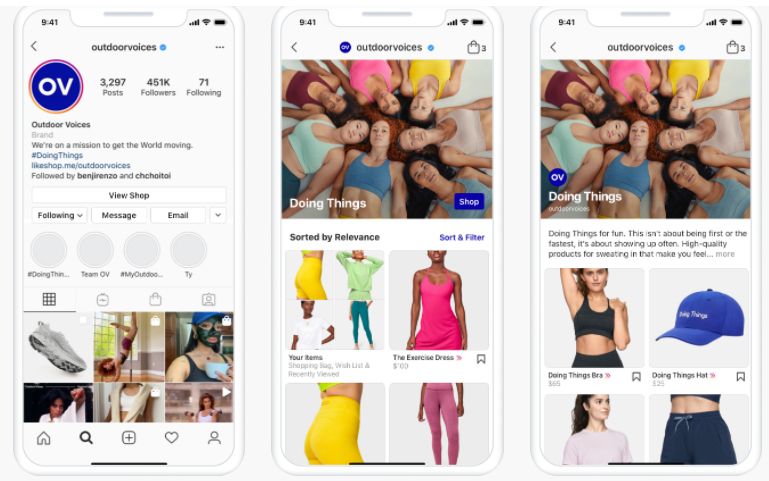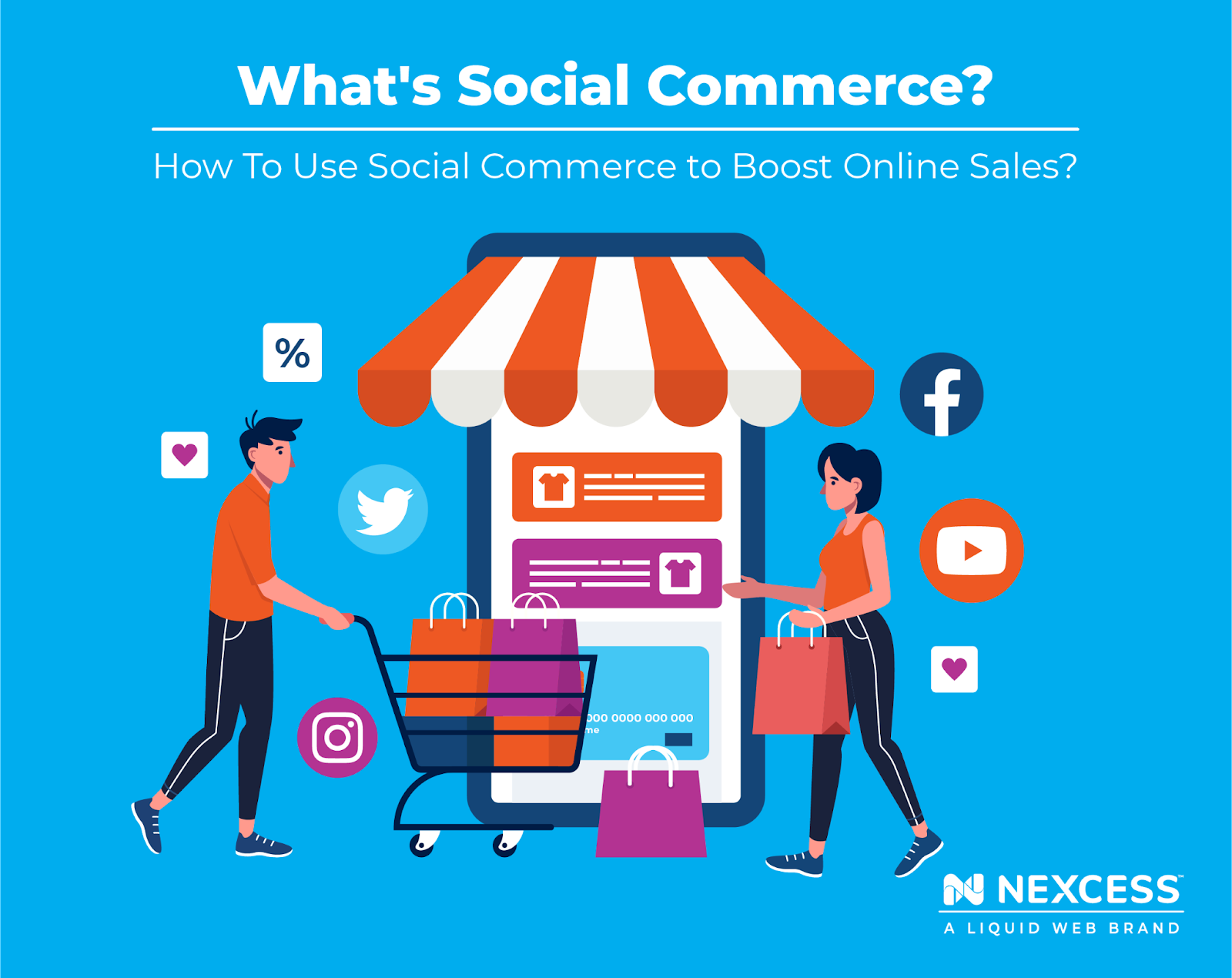Assume you come across a lovely winter jacket advertisement on social media. Will you click on the ad and navigate to the seller’s website immediately? Well, most people won’t.
According to Statista, the click-through rate of a social media advertisement is only 1.3%. It’s no surprise. Our urge not to leave social media sites is rooted deep in our brains.
But what if you don’t have to leave social media to purchase that winter jacket? For example, in the Instagram post below, you can click on the image and purchase the jacket without leaving Instagram. That is an example of social commerce.

People spend an average of 145 minutes a day on social networks. That’s 10% of their day. To tap into this opportunity, you should take your business where your customers are. Let’s see how social commerce can help you do it.
Here’s what you’ll learn:
- What Is Social Commerce?
- Social Commerce Examples
- Benefits of Social Commerce
- Final Thoughts: What Social Commerce Is and How To Use It To Boost Sales
What Is Social Commerce?
Social commerce is the strategy of selling products/services directly on social media. Social media users can simply click on your posts and complete the purchase without leaving the platform.
Facebook, Instagram, Snapchat, Pinterest, and Tiktok already support in-app sales through various tools. Twitter plans to join the league soon.
These social media platforms offer you tools for:
- Setting up your shop on social media
- Creating shoppable posts with purchase buttons
- Integrating your checkout flow on social media

Social Selling vs. Social Commerce
Businesses often use social media to enhance product discovery and spread brand awareness. They create posts, advertisements, and engage with customers through social media as part of their social selling strategy.
In essence, social selling focuses on driving traffic to ecommerce sites. In contrast, social commerce is hyper-focused on sales. It helps customers to complete the purchase without leaving social media platforms.
How Social Commerce Works
Now that you know the basics of social commerce let’s see how you can use popular social media platforms to sell your products.
Social Commerce on Instagram
Instagram provides various tools for SMBs to do social commerce. If you have an Instagram business account in the U.S., you’ll get several social commerce tools like:
- Instagram Checkout: Enables customers to buy products with just two taps from the product post to the checkout page.
- Instagram Shoppable Stories: Enables you to create Instagram stories with product stickers.
- Instagram Shops: Enables brands like yours to set up exclusive storefronts on Instagram.

Social Commerce on Facebook
In 2020, Facebook announced Facebook Shops. It enables small/medium businesses(SMBs) to set up their exclusive shops on Facebook.
Facebook has the following features to help SMBs:
- Product listing on a businesses’ Facebook page
- Check Out functionality to support in-app sales
- Customization of the shop to match the brand’s style
Facebook plans to charge a service fee for shops. However, if you want to try it out, it’s free until June 30, 2022.

Social Commerce on Snapchat
Snapchat brings its advanced augmented reality (AR) features to create a great online shopping experience.
With Shoppable AR advertisements, customers can virtually try on products and buy them right on Snapchat. Leading fashion brands like Gucci and Nike are using Snapchat’s social shopping features.
With all major social networks turning into social commerce platforms, you now have many options to sell through social media.
Businesses are already embracing social commerce, with 75% of ecommerce companies selling or planning to sell products on social media.
Here are a few examples to inspire you.
Social Commerce Examples
Many companies like yours have successfully boosted their online sales through social commerce. For example, Zimba, the teeth whitening brand, generated 1200 incremental orders from Facebook Shops.
Jane Boutique started using Instagram shopping features in 2020 July. Within nine months, they made $419,762 in incremental sales.

These are not isolated examples. According to Facebook, many SMBs in the U.S. have improved their revenues through social commerce.
Benefits of Social Commerce
- Social commerce makes purchasing super-easy as customers don't need to leave the social media site.
- It helps you hyper-target your customers based on their social media preferences.
- Social media sites provide excellent tools for sales monitoring.
- Social commerce exploits the impulse buying tendency of online customers.
- It helps you engage with your customers on a personal level, thus increasing customer loyalty.
- It helps take your business to the place where your potential customers like to hang out.
Social commerce is an excellent tool for improving sales. According to Business Insider, sales from social media platforms will reach $38.2 billion by 2022.
However, just setting up a social media shop isn’t sufficient. To capitalize on sales through social channels, you need an excellent social commerce strategy.
Here are a few pointers to maximize your sales.
Optimize Product Pricing

While on social media, customers make purchase decisions quickly, almost on impulse.
To capitalize on this buying pattern, you need to price your products intelligently. According to Shopify, $70 is the sweet spot for customers to impulse buy.
Customers think before buying a luxury item, so they might not sell well on social media.
Hence, to boost sales, you need to curate your product and price tags carefully.
Minimize Friction
Yes, it’s easy for customers to purchase from social media apps. For that, you need to streamline the in-app checkout flow and ensure hassle-free payments.
Customers might hesitate to purchase from your social media store if:
- The product doesn’t have enough information
- The product doesn’t have clear images/videos
- The payment method doesn’t look trustworthy
- Product shipping information is missing
Make sure customers have everything they need to complete their purchase right on the social media shop.
Engage Your Customers

Engaging with your customers is also essential for the success of your social media shop.
Here are some great ideas for customer engagement:
- Ask them to poll between two variations of a product.
- Feature your loyal customers on your storefront.
- Actively respond to customer comments and complaints.
Customers often have queries while purchasing online. You should quickly answer them before your customer moves away from your product. You can leverage messenger features on social media for this.
You also need to seek feedback from your existing customers actively. You should then display the reviews on your storefront. This social proof will attract more customers.
Final Thoughts: What Social Commerce Is and How To Use It To Boost Sales
Small/medium businesses worldwide use various social media strategies to reach more customers. Leading social media platforms, including Instagram, Facebook, and Snapchat, already have tools that can help you set up a store on their platform.
With social commerce, you can tap into a vast customer space. Are you ready to set up your online shop and boost your revenue through social commerce? Check out Nexcess’ WooCommerce hosting solution today.

